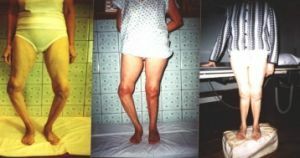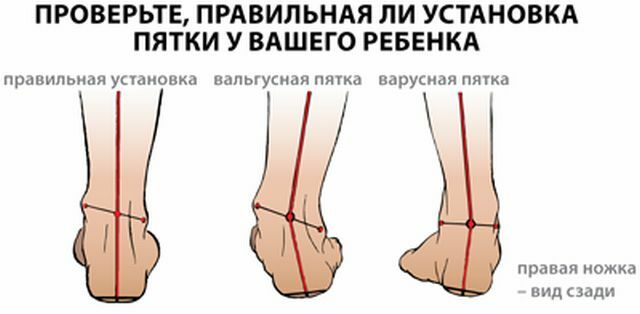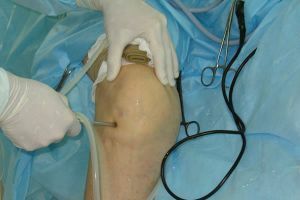 Arthroscopy of the knee joint - is a minimally invasive surgical intrusion of the into the joint.
Arthroscopy of the knee joint - is a minimally invasive surgical intrusion of the into the joint.
It is carried out for diagnosing or treating a number of orthopedic injuries, knee joint injuries and has qualitative advantages over open surgery.
Contents of the article
- What is the procedure of
- What is the procedure of
- Indications and contraindications for
- procedure How is
- performed? Consequences of procedure
- Rehabilitation and recovery
- Reviews of doctors and patients
- How much does the procedure and where can I do
What is the procedure of
In those cases when the patientdoes not help drug treatment - use surgical.
Arthroscopy of the knee joint in today's medicine and is the least traumatic surgical treatment of joints.
In modern medicine, diagnosis of diseases of the knee joints in most cases is carried out with the help of MRI( magnetic resonance imaging), however, this method does not always give 100% guarantee of the correctness of the diagnosis.
The video process of diagnosing the knee joint using this technique.
The operation is carried out with the help of specialized equipment of an arthroscope( a kind of endoscope - a device designed for penetration, internal inspection of organs) and high-precision optics connected to a high-resolution video camera.
All manipulations performed during surgery with joints are visible on the monitor with multiple magnifications.
In contrast to open surgery with AKD , the traumatism of tissue, cartilaginous and ligamentous tissues is so minimal that the reduction process is reduced many times, increasing the chance for successful recovery of the patient.
Indications and contraindications to procedure
Prolonged or non-stopping pains and swelling in the knee joint, difficulty in turning, moving or flexing-extension, injury during exercise - all this indicates the need to visit the orthopedic doctor.
Indications for arthroscopy of the knee joint are: 
- rupture, ligament injury or meniscus( one or two);
- unclear clinical manifestations of the disease or trauma;
- lesions of cartilage tissue, Koening's disease;
- chronic synovitis;
- avascular necrosis of bone tissue COP, etc.
These can become:
- fusion of bone, cartilage or other joint tissues to complete immobility of the joint;
- systemic chronic diseases( severe stages of diabetes mellitus, cardiovascular system, etc.);
- wounds in the CS area, complicated by infections or purulent-inflammatory foci;
- severe injuries with large hemorrhages in the joint cavity.
How is the operation
This surgical operation involves anesthesia.
It is selected depending on the patient's tolerability of one or another type of medication, the time of the operation or simply the preference of the operated( local, spinal, general anesthesia).
Three incisions are made in the region of the knee joint( from 4 to 7 mm). An arthroscope is introduced into one , which transmits a clear, magnified picture( up to 60 times) to the monitor.
The second and third for inputting the toolkit.
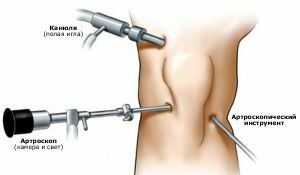 A special liquid( saline solution) is supplied through the second( inflow and outflow tube) to increase the cavity and improve visibility, as well as the liquid is removed, together with fragments of the tissue material. Through the third appropriate instrument, the surgical operation itself is performed( the one that is shown in this type of disease or injury).
A special liquid( saline solution) is supplied through the second( inflow and outflow tube) to increase the cavity and improve visibility, as well as the liquid is removed, together with fragments of the tissue material. Through the third appropriate instrument, the surgical operation itself is performed( the one that is shown in this type of disease or injury).
After surgery, sutures are applied to the wound, which are closed with a bandage made of gauze. Usually the bandages are removed on the third day and the wounds are covered with a band-aid.
Consequences of procedure
Statistical data on performed operations on the knee joint show that the consequences after arthroscopy, if performed by a professional, are minimal( up to half a percent).
But still they can occur:
- fever, chills or fever;
- periodic, constant or increasing pain in the joint, redness of the skin or increase in its temperature around the CS;
- pain giving to the hip joint or calf muscles;
- progressive edema.
The cause of this condition can be complications that occur both during the operation and after it.
During the procedure may be:
- large blood vessels( artery or vein) are affected;
- during the operation may break off the small parts of the instrument and stay in the cavity of the COP;
- manipulation of the instrument, conducted with the application of force, can lead to sprains( lateral inner).
After operation:
- occurrence of infectious diseases( arthritis, bursitis);
- filling the joint cavity with blood( hemarthrosis);
- inflammation of postoperative scars;
- dysfunction of nerve endings in the area of surgery leads to tissue damage and pain syndrome( algodostrophic);
- is a thromboembolic problem.
With the timely access to the doctor , all cases are curable .In extreme cases, there is a need for a new surgical intervention - joint flushing and medical treatment.
Rehabilitation and rehabilitation
After the arthroscopy, rehabilitation procedures begin, which can last from 2 days to 2 weeks.
Dressings, analgesic and anti-inflammatory drug therapy, if necessary - therapeutic or cooling compresses, massage, 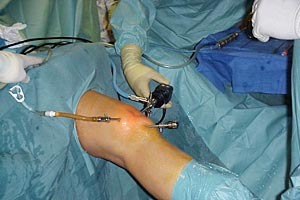 electrophysiologic procedures.
electrophysiologic procedures.
Also assigned a special assigned complex exercise therapy.
Do not forget the first week:
- , alternations of load and rest must be performed strictly as directed by the doctor;
- several times a day - cold compress;
- wearing a fixing bandage or bandage from an elastic bandage;
- in the horizontal position of the CS should be above the level of the chest.
Reviews of Doctors and Patients
Let's study the responses of doctors and patients to know what knee arthroscopy really is.
Knee injury was received while skiing. Excruciated by severe pain, she turned to the orthopedist. After the diagnosis( a break in the meniscus and anterior cruciate ligament) - sent to the operation.
Low bow to doctors( did based on 59 CCB) and all the medical staff, competent and very attentive people. Days after 6 after the operation went herself, the rehabilitation went well and no problems and complications! I will continue to follow the advice of a doctor, so that only memories remain about the trauma))).
Elena K., 32, 14.03.14
Before deciding on an operation - check out the clinic reviews! I was injured, the cruciate ligament ruptured, I first got to the doctors who only aggravated my positions with prolonged treatment.
After arthroscopy - the leg is like new))).You need to make efforts, be disciplined during the rehabilitation period, listen to the doctor and everything will be in order!
Nikolay M., 26 years old, 05/17/19
I operated on my knee, before this pain I was tortured for about 3 years. Many thanks to surgeons and rehabilitologists. Only a week passed after the operation - and the pain is no longer excruciating, the restoration is in full swing.
Anesthesia was selected and conducted well, almost no negative effects were felt. In a word - happy! I wish you health and a bow from me.
Nadezhda L., age 42, 03.06.14
AKS is a full-fledged operation, but it does not require the full opening of the joint, which means that the rehabilitation period is fewer times and the risks of complications are minimal. But nevertheless I want to warn - at first an establishment of the correct diagnosis, and already then operation. And do not neglect the radiography, it often reflects the problem better.
Kostin AP, 41, doctor-orthopedist
Knee joint disease is one of the most common health problems. Do not self-medicate. Today's level of science and technology is such that arthroscopy is not a very complicated and traumatic operation. However, as a professional I can advise - consultation of 2-3 doctors will help in establishing the correct diagnosis.
Gordin SM, 46 years old, orthopedic traumatologist, ASM
 Learn more about the gel. The horsepower for the joints you can have studied our material on this topic.
Learn more about the gel. The horsepower for the joints you can have studied our material on this topic.
Have you decided to buy a tourmaline belt? Find out what dangers you might face when buying and using this orthopedic device.
How much does the procedure cost and where can I do
The cost of an operation on the knee joint depends on the complexity of the operation and the clinic in which it is produced.
To date, such an operation can cost from 15,000 to 105,000 rubles .Prices for arthroscopy of the knee joint for diagnostic purposes, from 5-6 thousand rubles to 11 thousand.
This operation requires high-precision medical equipment, therefore it is carried out, mainly in large cities of our country, but throughout the territory of the Russian Federation.
Treatment can be obtained from such clinics:
- FSI "CITO im. N.N.Priory ";
- Clinic of Vascular and Joint Surgery;
- Moscow SPC of sports medicine;
- clinic on the basis of GKB No. 59;
- Russian NIITO to them. R.R.Harmful( St. Petersburg);
- ЦНМТ( Novosibirsk);
- MC Myrt;
- SportsClub( St. Petersburg);
- City Clinical Hospital No. 6( Penza City), etc.


